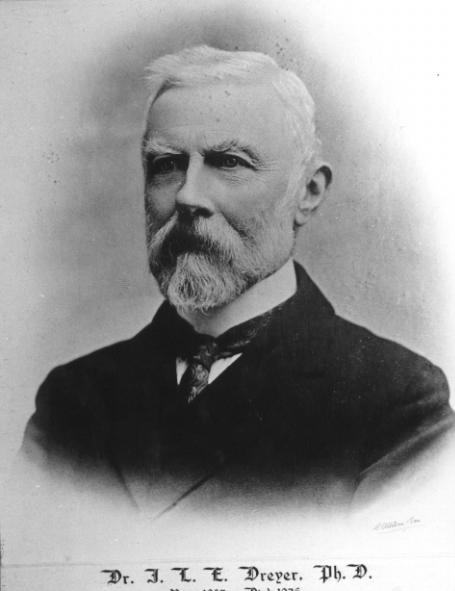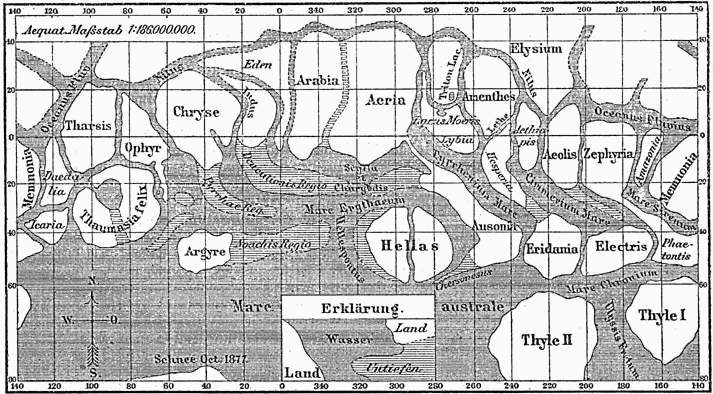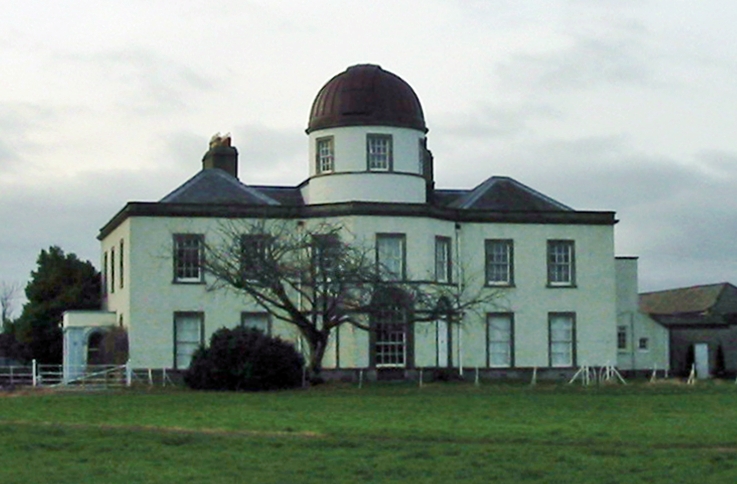|
Charles E. Burton
Charles Edward Burton (16 September 1846 – 9 July 1882) was a British-born Irish astronomer. Early life He was born to Irish parents in Barnton, Cheshire, where his father, Reverend Edward. W. Burton, held a church benefice. Suffering from ill-health, he was privately educated. By the age of 15 he had become very interested in astronomy, experimenting with celestial photography. The family returned to Ireland, where Rev. Burton was appointed curate of Rathmichael Church, Loughlinstown, County Dublin. Career He joined Lawrence Parsons's (Lord Rosse) observatory in February 1868 as an assistant astronomer, using a small transit telescope and learning to grind mirrors up to 15 inches (38 cm) in diameter for telescopes; in the 1840s, William Parsons (3rd Earl) had built the world's largest telescope at Parsonstown ( Birr from 1899), a 72-inch (183 cm) reflector. The mirrors ground by Burton were regarded as beyond compare. Later in 1868, Burton gained a B.A. from Trin ... [...More Info...] [...Related Items...] OR: [Wikipedia] [Google] [Baidu] |
Barnton, Cheshire
Barnton is a civil parish and village in the northwest region of England, just outside the town of Northwich, in the unitary authority of Cheshire West and Chester and the ceremonial county of Cheshire. It lies north and east of the Trent & Mersey Canal which goes through two tunnels (Barnton and Saltersford) to the west of the village. The village can roughly be divided into four parts: the old village which grew northeastwards from the southwest corner; the more up-market properties northwest-wards along and to the west of the main Runcorn Road ( A533); the council-built estate to the north west, largely between Townfield Lane and Runcorn Road; and the more modern estates (the largest known as the Locke estate after the builders) to the north and east. The village has no easily identifiable centre with some shops along the Runcorn Road and others by the new Health Centre in Lydyett Lane. There is currently only one pub, a small number for such a large village and greatly fewer ... [...More Info...] [...Related Items...] OR: [Wikipedia] [Google] [Baidu] |
Transit Of Venus, 1874
The 1874 transit of Venus, which took place on 9 December 1874 (01:49 to 06:26 UTC), was the first of the pair of transits of Venus that took place in the 19th century, with the second transit occurring eight years later in 1882. The previous pair of transits had taken place in 1761 and 1769, and the next pair would not take place until 2004 and 2012. As with previous transits, the 1874 transit would provide an opportunity for improved measurements and observations. Numerous expeditions were planned and sent out to observe the transit from locations around the globe, with several countries setting up official committees to organise the planning. There were six official French expeditions. One expedition went to New Zealand's Campbell Island, the other five travelling to Île Saint-Paul in the Indian Ocean, Nouméa in New Caledonia in the Pacific, Nagasaki in Japan (with an auxiliary station in Kobe), Peking in China, and Saigon in Vietnam. There were five official British ex ... [...More Info...] [...Related Items...] OR: [Wikipedia] [Google] [Baidu] |
NASA
The National Aeronautics and Space Administration (NASA ) is an independent agency of the US federal government responsible for the civil space program, aeronautics research, and space research. NASA was established in 1958, succeeding the National Advisory Committee for Aeronautics (NACA), to give the U.S. space development effort a distinctly civilian orientation, emphasizing peaceful applications in space science. NASA has since led most American space exploration, including Project Mercury, Project Gemini, the 1968-1972 Apollo Moon landing missions, the Skylab space station, and the Space Shuttle. NASA supports the International Space Station and oversees the development of the Orion spacecraft and the Space Launch System for the crewed lunar Artemis program, Commercial Crew spacecraft, and the planned Lunar Gateway space station. The agency is also responsible for the Launch Services Program, which provides oversight of launch operations and countdown management f ... [...More Info...] [...Related Items...] OR: [Wikipedia] [Google] [Baidu] |
Mercator Projection
The Mercator projection () is a cylindrical map projection presented by Flemish geographer and cartographer Gerardus Mercator in 1569. It became the standard map projection for navigation because it is unique in representing north as up and south as down everywhere while preserving local directions and shapes. The map is thereby conformal. As a side effect, the Mercator projection inflates the size of objects away from the equator. This inflation is very small near the equator but accelerates with increasing latitude to become infinite at the poles. As a result, landmasses such as Greenland, Antarctica and Russia appear far larger than they actually are relative to landmasses near the equator, such as Central Africa. History There is some controversy over the origins of the Mercator. German polymath Erhard Etzlaub engraved miniature "compass maps" (about 10×8 cm) of Europe and parts of Africa that spanned latitudes 0°–67° to allow adjustment of his portable pocket-s ... [...More Info...] [...Related Items...] OR: [Wikipedia] [Google] [Baidu] |
John Louis Emil Dreyer
John Louis Emil Dreyer (13 February 1852 – 14 September 1926) was a Danish astronomer who spent most of his career working in Ireland. He spent the last decade of his life in Oxford, England. Life Dreyer was born in Copenhagen. His father, Lieutenant General John Christopher Dreyer, was the Danish Minister for War and the Navy. When he was 14 he became interested in astronomy and regularly visited Hans Schjellerup at the Copenhagen observatory. He was educated in Copenhagen, taking an MA in 1872. While the same university later awarded him a PhD, in 1874. But in 1874, at the age of 22, he went to Parsonstown, Ireland. There he worked as the assistant of Lord Rosse (the son and successor of the Lord Rosse who built the Leviathan of Parsonstown telescope). During 1878 he moved to Dunsink, the site of the Trinity College Observatory of Dublin University to work for Robert Stawell Ball. In 1882 he relocated again, this time to Armagh Observatory, where he served as Director u ... [...More Info...] [...Related Items...] OR: [Wikipedia] [Google] [Baidu] |
Martian Canals
During the late 19th and early 20th centuries, it was erroneously believed that there were "canals" on the planet Mars. These were a network of long straight lines in the equatorial regions from 60° north to 60° south latitude on Mars, observed by astronomers using early telescopes without photography. They were first described by the Italian astronomer Giovanni Schiaparelli during the opposition of 1877, and confirmed by later observers. Schiaparelli called these ''canali'' ("channels"), which was mis-translated into English as "canals". The Irish astronomer Charles E. Burton made some of the earliest drawings of straight-line features on Mars, although his drawings did not match Schiaparelli's. Around the turn of the century there was even speculation that they were engineering works, irrigation canals constructed by a civilization of intelligent aliens indigenous to Mars. By the early 20th century, improved astronomical observations revealed the "canals" to be an optical illu ... [...More Info...] [...Related Items...] OR: [Wikipedia] [Google] [Baidu] |
Giovanni Schiaparelli
Giovanni Virginio Schiaparelli ( , also , ; 14 March 1835 – 4 July 1910) was an Italian astronomer and science historian. Biography He studied at the University of Turin, graduating in 1854, and later did research at Berlin Observatory, under Encke. In 1859–1860 he worked in Pulkovo Observatory near St Petersburg, and then worked for over forty years at Brera Observatory in Milan. He was also a senator of the Kingdom of Italy, a member of the Accademia dei Lincei, the Accademia delle Scienze di Torino and the Regio Istituto Lombardo, and is particularly known for his studies of Mars. Mars Among Schiaparelli's contributions are his telescopic observations of Mars. In his initial observations, he named the "seas" and "continents" of Mars. During the planet's "great opposition" of 1877, he observed a dense network of linear structures on the surface of Mars, which he called in Italian, meaning "channels", but the term was mistranslated into English as "canals".Washa ... [...More Info...] [...Related Items...] OR: [Wikipedia] [Google] [Baidu] |
Opposition (planets)
In positional astronomy, two astronomical objects are said to be in opposition when they are on opposite sides of the celestial sphere, as observed from a given body (usually Earth). A planet (or asteroid or comet) is said to be "in opposition" or "at opposition" when it is in opposition to the Sun. Because most orbits in the Solar System are nearly coplanar to the ecliptic, this occurs when the Sun, Earth, and the body are configured in an approximately straight line, or syzygy; that is, Earth and the body are in the same direction as seen from the Sun. Opposition occurs only for superior planets (see the diagram). The instant of opposition is defined as that when the apparent geocentric celestial longitude of the body differs by 180° from the apparent geocentric longitude of the Sun. At that time, a body is: * in apparent retrograde motion * visible almost all night – rising around sunset, culminating around midnight, and setting around sunrise * at the point in its o ... [...More Info...] [...Related Items...] OR: [Wikipedia] [Google] [Baidu] |
Dublin
Dublin (; , or ) is the capital and largest city of Republic of Ireland, Ireland. On a bay at the mouth of the River Liffey, it is in the Provinces of Ireland, province of Leinster, bordered on the south by the Dublin Mountains, a part of the Wicklow Mountains range. At the 2016 census of Ireland, 2016 census it had a population of 1,173,179, while the preliminary results of the 2022 census of Ireland, 2022 census recorded that County Dublin as a whole had a population of 1,450,701, and that the population of the Greater Dublin Area was over 2 million, or roughly 40% of the Republic of Ireland's total population. A settlement was established in the area by the Gaels during or before the 7th century, followed by the Vikings. As the Kings of Dublin, Kingdom of Dublin grew, it became Ireland's principal settlement by the 12th century Anglo-Norman invasion of Ireland. The city expanded rapidly from the 17th century and was briefly the second largest in the British Empire and sixt ... [...More Info...] [...Related Items...] OR: [Wikipedia] [Google] [Baidu] |
Dunsink Observatory
The Dunsink Observatory is an astronomical observatory established in 1785 in the townland of Dunsink in the outskirts of the city of Dublin, Ireland.Alexander Thom''Irish Almanac and Official Directory''7th ed., 1850 p. 258. Retrieved: 2011-02-22. Dunsink's most famous director was William Rowan Hamilton, who, amongst other things, discovered quaternions, the first non-commutative algebra form, while walking from the observatory to the city with his wife. The annual Hamilton Walk that commemorates this discovery begins at the observatory. He is also renowned for his Hamiltonian formulation of dynamics. History The observatory was established by an endowment of £3,000 in the will of Francis Andrews, who was Provost of Trinity College Dublin at his death on 18 June 1774. The site was established on the south slope of a low hill in the townland of Dunsink, 84m above sea level. The South Telescope, a 12-inch Grubb instrument, is a refracting (i.e. it uses lens) telescope built ... [...More Info...] [...Related Items...] OR: [Wikipedia] [Google] [Baidu] |
Greenwich Observatory
The Royal Observatory, Greenwich (ROG; known as the Old Royal Observatory from 1957 to 1998, when the working Royal Greenwich Observatory, RGO, temporarily moved south from Greenwich to Herstmonceux) is an observatory situated on a hill in Greenwich Park in south east London, overlooking the River Thames to the north. It played a major role in the history of astronomy and navigation, and because the Prime Meridian passes through it, it gave its name to Greenwich Mean Time, the precursor to today's Coordinated Universal Time (UTC). The ROG has the IAU observatory code of 000, the first in the list. ROG, the National Maritime Museum, the Queen's House and the clipper ship ''Cutty Sark'' are collectively designated Royal Museums Greenwich. The observatory was commissioned in 1675 by King Charles II, with the foundation stone being laid on 10 August. The old hilltop site of Greenwich Castle was chosen by Sir Christopher Wren, a former Savilian Professor of Astronomy; as Greenw ... [...More Info...] [...Related Items...] OR: [Wikipedia] [Google] [Baidu] |
Nebula
A nebula ('cloud' or 'fog' in Latin; pl. nebulae, nebulæ or nebulas) is a distinct luminescent part of interstellar medium, which can consist of ionized, neutral or molecular hydrogen and also cosmic dust. Nebulae are often star-forming regions, such as in the "Pillars of Creation" in the Eagle Nebula. In these regions, the formations of gas, dust, and other materials "clump" together to form denser regions, which attract further matter, and eventually will become dense enough to form stars. The remaining material is then thought to form planets and other planetary system objects. Most nebulae are of vast size; some are hundreds of light-years in diameter. A nebula that is visible to the human eye from Earth would appear larger, but no brighter, from close by. The Orion Nebula, the brightest nebula in the sky and occupying an area twice the angular diameter of the full Moon, can be viewed with the naked eye but was missed by early astronomers. Although denser than the space ... [...More Info...] [...Related Items...] OR: [Wikipedia] [Google] [Baidu] |

.jpg)






